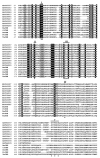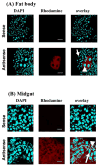Identification and characterization of juvenile hormone esterase gene from the yellow fever mosquito, Aedes aegypti
- PMID: 17628281
- PMCID: PMC2020842
- DOI: 10.1016/j.ibmb.2007.05.010
Identification and characterization of juvenile hormone esterase gene from the yellow fever mosquito, Aedes aegypti
Abstract
Juvenile hormone esterase (JHE) plays an important role in regulating juvenile hormone titers. Recent sequencing and annotation of the Aedes aegypti genome identified ten putative jhe gene sequences. Analysis of these ten putative jhe gene sequences showed that only three of them, EAT43357, EAT43353 and EAT43354 contained GQSAG motif and showed high sequence similarity with the sequences of jhe genes identified from other insect species. To determine which putative jhe gene(s) code for functional JHE, the mRNA profiles of EAT43357, EAT43353 and EAT43354 were measured during the final instar larval and pupal stages by using quantitative real-time reverse transcriptase polymerase chain reaction (PCR). The mRNA for EAT43357 was detected during the late final instar larval stage. In contrast, EAT43354 mRNA was detected only during the pupal stage and EAT43353 mRNA was detected only during the larval stage. The mRNA of EAT43357 was detected in both fat body and midgut tissues. JHE enzyme levels gradually increased during the final instar larval stage reaching a peak at 42 h after ecdysis into the final instar larval stage. The mRNA expression profiles of EAT43357 correlate with the developmental expression profiles of JHE enzyme activity suggesting that this gene may encode for a functional JHE. The EAT43357 and EAT43354 cDNA were expressed in a baculovirus system. Proteins isolated from Sf9 cells infected with recombinant baculovirus expressing EAT43357 but not EAT43354 gene exhibited JHE activity confirming that EAT43357 gene codes for a functional JHE enzyme.
Figures







Similar articles
-
Molecular cloning and characterization of a juvenile hormone esterase gene from brown planthopper, Nilaparvata lugens.J Insect Physiol. 2008 Dec;54(12):1495-502. doi: 10.1016/j.jinsphys.2008.08.010. Epub 2008 Aug 30. J Insect Physiol. 2008. PMID: 18804476
-
A whole genome screening and RNA interference identify a juvenile hormone esterase-like gene of the diamondback moth, Plutella xylostella.J Insect Physiol. 2015 Sep;80:81-7. doi: 10.1016/j.jinsphys.2015.02.001. Epub 2015 Feb 24. J Insect Physiol. 2015. PMID: 25721055
-
Molecular cloning and developmental expression of the gene encoding juvenile hormone esterase in the yellow-spotted longicorn beetle, Psacothea hilaris.Insect Biochem Mol Biol. 2007 May;37(5):497-505. doi: 10.1016/j.ibmb.2007.02.006. Epub 2007 Mar 3. Insect Biochem Mol Biol. 2007. PMID: 17456444
-
cDNA cloning and characterization of Bombyx mori juvenile hormone esterase: an inducible gene by the imidazole insect growth regulator KK-42.Insect Biochem Mol Biol. 2002 Jun;32(6):627-35. doi: 10.1016/s0965-1748(01)00141-2. Insect Biochem Mol Biol. 2002. PMID: 12020837
-
Juvenile hormone (JH) esterase activity but not JH epoxide hydrolase activity is downregulated in larval Adoxophyes honmai following nucleopolyhedroviruses infection.J Insect Physiol. 2015 Sep;80:71-80. doi: 10.1016/j.jinsphys.2015.02.005. Epub 2015 Feb 26. J Insect Physiol. 2015. PMID: 25727179
Cited by
-
Genome-wide comparison of genes involved in the biosynthesis, metabolism, and signaling of juvenile hormone between silkworm and other insects.Genet Mol Biol. 2014 Jun;37(2):444-59. doi: 10.1590/s1415-47572014005000006. Genet Mol Biol. 2014. PMID: 25071411 Free PMC article.
-
RNA-Seq reveals early distinctions and late convergence of gene expression between diapause and quiescence in the Asian tiger mosquito, Aedes albopictus.J Exp Biol. 2013 Nov 1;216(Pt 21):4082-90. doi: 10.1242/jeb.089508. Epub 2013 Aug 2. J Exp Biol. 2013. PMID: 23913949 Free PMC article.
-
Annotation and expression of carboxylesterases in the silkworm, Bombyx mori.BMC Genomics. 2009 Nov 24;10:553. doi: 10.1186/1471-2164-10-553. BMC Genomics. 2009. PMID: 19930670 Free PMC article.
-
Function of phenylalanine 259 and threonine 314 within the substrate binding pocket of the juvenile hormone esterase of Manduca sexta.Biochemistry. 2010 May 4;49(17):3733-42. doi: 10.1021/bi901641x. Biochemistry. 2010. PMID: 20307057 Free PMC article.
-
Dynamic Roles of Insect Carboxyl/Cholinesterases in Chemical Adaptation.Insects. 2023 Feb 16;14(2):194. doi: 10.3390/insects14020194. Insects. 2023. PMID: 36835763 Free PMC article. Review.
References
-
- Bonning BC, Hoover K, Booth TF, Duffey S, Hammock BD. Development of a recombinant baculovirus expressing a modified juvenile hormone esterase with potential for insect control. Arch Insect Biochem Physiol. 1995;30:177–194.
-
- Bradford MM. Rapid and sensitive method for quantitation of microgram quantities of protein utilizing principle of protein dye binding. Anal Biochem. 1976;72:248–254. - PubMed
-
- Campbell PM, Harcourt RL, Crone EJ, Claudianos C, Hammock BD, Russell RJ, Oakeshott JG. Identification of a juvenile hormone esterase gene by matching its peptide mass fingerprint with a sequence from the Drosophila genome project. Insect Biochem Mol Biol. 2001;31:513–520. - PubMed
-
- Campbell PM, Healy MJ, Oakeshott JG. Characterization of juvenile hormone esterase in Drosophila melanogaster. Insect Biochem Mol Biol. 1992;22:665–677. - PubMed
Publication types
MeSH terms
Substances
Grants and funding
LinkOut - more resources
Full Text Sources

